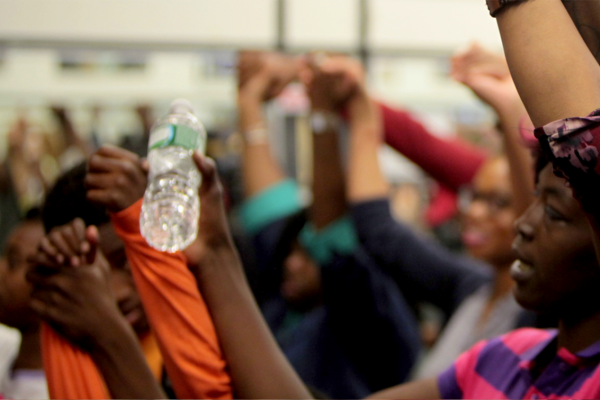IN DECEMBER 2014, the United Nations approved a resolution put forth by Bangladesh and more than 100 other countries that included a reference to “unarmed civilian protection.” This was the first time the phrase had been referenced in an official U.N. General Assembly document.
The following year, a U.N. report noted that “unarmed civilian protection is a method for direct protection of civilians and violence reduction that has grown in practice and recognition. In the last few years, it has especially proven its effectiveness to protect women and girls.”
Last fall, Tiffany Easthom, executive director of Nonviolent Peaceforce, addressed a special U.N. session on unarmed civilian protection with a bold proposal: “The [U.N.] Security Council could ensure the centrality of unarmed strategies in protection of civilian mandates.”
Unarmed civilian protection, or UCP, is just what it sounds like: nonviolent action by civilians to protect other civilians from political violence. The peacekeeping practice is rooted in the call for a “peace army”—a Shanti Sena—by Mohandas Gandhi and Khan Abdul Ghaffar Khan, whom the pope referenced in his 2017 World Day of Peace message.
Peace Brigades International is generally credited with initiating the current practice in the 1980s in Guatemala. Peace Brigades International focused on specific strategies based on the principles and practices of nonviolence, the primacy of local actors, independence, and for many but not all organizations, nonpartisanship, in an organized, disciplined way.
Many organizations around the world are currently practicing this method of intervention, including Peace Brigades International, Nonviolent Peaceforce, Christian Peacemaker Teams, SweFOR, Meta Peace Team, Operation Dove, Ecumenical Accompaniment Programme in Palestine and Israel, the Presbyterian Peace Fellowship, and others.
Christian Peacemaker Teams, for example, operates in Mexico, Kurdistan, Colombia, Palestine, First Nations territories in Canada, the Democratic Republic of the Congo, and the United States. Its mission is to wage unarmed intervention “by committed peacemakers ready to risk injury and death in bold attempts to transform lethal conflict through the nonviolent power of God’s truth and love.”
Strategies of unarmed civilian protection have effectively defended people in a wide variety of contexts and cultures. Both the Meta Peace Team and Nonviolent Peaceforce recently have responded to invitations to work with the Standing Rock community and resistance in North Dakota.
HOW DOES UNARMED civilian protection work? In a community experiencing threats and acts of violence against people, an interfaith group might decide to receive training in unarmed protection. Based on that training and analysis of the context, the group might reach out to opposing groups.
For example, they might contact the police to discuss the police’s role and also reach out to organizations fomenting violence and to people receiving threats of violence. From those conversations specific protection plans would be developed. Currently there are all-women unarmed civilian protection teams successfully operating in the Philippines and South Sudan, contributing to community security.
Why does it work? Often people will respond when called specifically and directly to do their jobs (police), or to act humanely (various community groups and individuals), not only because they are reminded of their own humanity but because they know others are watching them and they may be reported on. Additionally, initial contacts may lead to shared meetings, helping people to know each other and respond to each other’s needs. Violence often requires anonymity and a pack mentality to be carried out. Shining a light on the sources of threats may make that anonymity impossible. Direct communication can break up the pack mentality.
Last fall, Nonviolent Peaceforce joined with Australia, Costa Rica, the Netherlands, and the Philippines at a high-level U.N. briefing to deepen understanding about this cost-effective, highly durable method of conflict prevention, intervention, and post-conflict transformation.
“Peacekeeping began as an unarmed endeavor,” said Ralph Mamiya, of the U.N. Department of Peacekeeping Operations. “Those are its origins. It’s become increasingly armed and increasingly militarized over the years, but the first [U.N.] peacekeepers did not carry weapons.”
Nothing is guaranteed to stop violence. Unarmed civilian protection is not magic. But a well-developed set of principles and practices that works, all over the world, is worth supporting.

Got something to say about what you're reading? We value your feedback!

